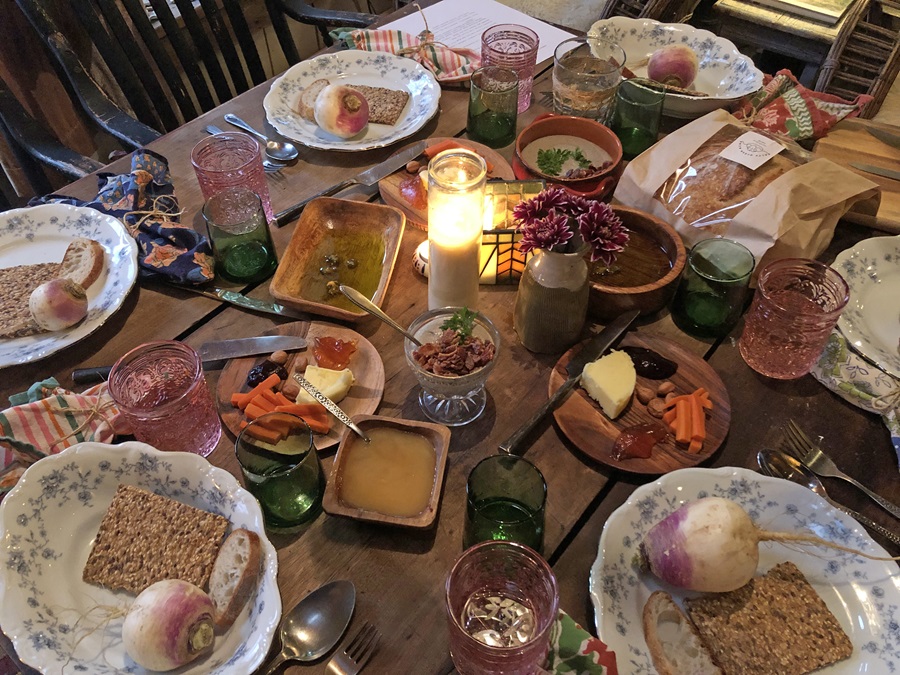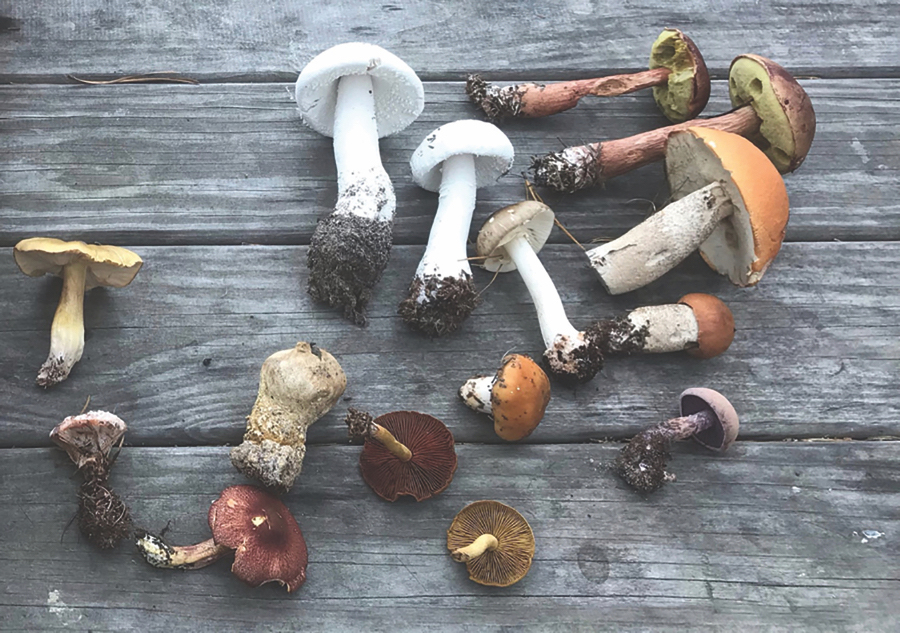Nicole Cormier often dances, all by herself and spontaneously, in the kitchen of her North Truro cottage. And when she cooks, she likes to harness that same kind of improvisational energy.
Cormier talks about her approach to nutrition as a practice — a term often employed by artists, yogis, or religious devotees to refer to an activity that is intuitive yet disciplined and broad in scope. It’s a fitting way to think about her vocation: Cormier is a registered dietician who is a bit of an evangelist. Her company, Delicious Living, offers nutrition counseling. And this winter she’s been hosting dinners she hopes will cultivate her guests’ healthy connections to the food they eat.
On a snowy February evening, Cormier is taking over the kitchen and dining room at Nate McKean and Braunwyn Jackett’s Truro house, where, over the past few months, she has held her Scrubby Pines Supper Club.

A dozen of us are there for a dinner that encourages us to explore local ingredients and take a more impromptu approach to them. This is not a cooking class. In fact, her goal is to help us “let go of a recipe mindset.”
Cormier usually begins preparations for her Tuesday evening dinners the Saturday before. The process starts with a trip to the Orleans farmers market to see what’s available. Afterwards, she’ll text around to her local farmer friends, asking what they have. “This is how I shop,” she says.
What she’s searching for is a balanced set of ingredients: proteins, fibers, greens, root vegetables, seasonal fruits, and always something fermented, she says. Only after she has sourced an array of local ingredients will she begin assembling a menu.
As the dinner gets underway, Cormier pours us each a glass of raw milk that she brought from Maine, where she had recently been on a skiing trip. “You don’t have to drink your milk, but you can,” she says. The glass of milk is intended as an opening for diners to explore their past relationships to sitting down at the dinner table. “Some people had to drink their milk when they were growing up,” Cormier says.
Our plates are set with a whole raw turnip, a cracker, and slice of bread. When I first heard that the dinner would feature local and foraged ingredients, I was worried that I might leave hungry. This was February on Cape Cod, after all. Staring down my turnip, my fear is not assuaged.
But then, bite by bite, Cormier brings me along.
“I always start the meal with something that will stimulate digestion,” says Cormier. The purple turnip came fresh from Pariah Dog Farm in Falmouth that morning. Left to figure out how to approach the whole roots, some of us slice them into pieces. Others just bite in. “It tastes like a spicy apple,” someone says. I can’t help finding the turnip refreshing.
The bread, which Cormier has also picked up that day, is from Salty Ocean Acre in Falmouth. Like the turnips, the loaves are left whole, so each table has to work out how to share it, either by slicing or tearing it into pieces.
Cormier makes a point of introducing the farmers and producers from whom she sources her ingredients. “If you know where something is coming from, you’re building a stronger relationship to the food,” she says.
The meal’s opening flavors ricochet between extremes in an engaging way. The raw milk and raw butter are mellow, mild accompaniments to the bread, but alongside them on our tables are spicy carrots and crabapple-jalapeño jelly from StoneLedge Gardens in Randolph. There is also raw honey for drizzling on a buttered hunk of bread or perhaps on a slice of turnip.
Heartier appetizers follow. My favorite is a cream of mushroom dip that plays on the one those reared on Campbell’s might recall. Cormier reimagines it with goat’s milk yogurt and soaked cashews, the technique “a template for people to consider different ways of doing things,” she says.

The mushrooms were foraged locally in the fall: Cormier gathered the boletes during walks in the Province Lands and found the hen-of-the-woods growing at the bottom of hemlock and oak trees near her home in North Truro. She freezes both varieties and uses them throughout the year. The mushroom dip has a pleasant earthy, nutty taste, and the yogurt gives the dip a lighter, springier effect than does the cream often used in this appetizer. Eating it puts me in mind of a walk in a moist forest.
For the main course, Cormier serves roasted chicken from Truro’s Hillside Farms alongside crispy foraged ramps. She arranges the dish with a nutritional balance in mind: shredded turnips and black beans underneath the chicken provide fiber, and so does the dark leafy young kale on top. She harvested it from her garden before the snowstorm.
From her point of view, this is about having enough protein and fiber to slow the rate of digestion and ensure vitamins and minerals will be properly absorbed into our bodies. For the rest of us, it is a warm, comforting dish that nicely balances the astringent flavors of turnip and ginger against the richness of the chicken and black beans.
Cormier plays with contrasts all the way through to dessert, this time juxtaposing sweet and sour flavors in a treat that combines yogurt and cranberries with peaches and a drizzle of honey. A sprinkle of granola on the top adds crunch.
The evening proves I needn’t have worried about what a foraged dinner might mean in February. With thanks to local farmers, smart use of a freezer in seasons past, and an improvised dance or two, a winter feast can come from what Cormier calls “the nooks and crannies of the Cape.”
WILD MUSHROOM DIP
Makes about 3 cups
Note: Cormier uses foraged mushooms, Monopati olive oil that Maria Lemanis and Georgios Tselepis bring to Outer Cape farmers markets from their family’s groves near Kalamata, Greece, and bacon from Hillside Farm in Truro.
1 cup raw cashews, soaked for a few hours
1 cup wild mushrooms, such as a mix of hen-of-the-woods and boletes (frozen or rehydrated)
2 Tbsp. olive oil
Sea salt and black pepper to taste
2 cups goat’s milk yogurt
2 slices Hillside Farm bacon, cooked in the oven and crumbled
Garden parsley, minced, as a garnish
- Soak the cashews in water for 2 to 6 hours, then drain and let dry.
- Sauté the mushrooms in olive oil until they’re golden brown, seasoning them with a sprinkle of salt and pepper.
- Place mushrooms and cashews in a high-speed blender or food processor and blend until smooth. Add the goat’s milk yogurt and season the dip to taste with salt and pepper. To serve, top with crumbled bacon and minced parsley.



